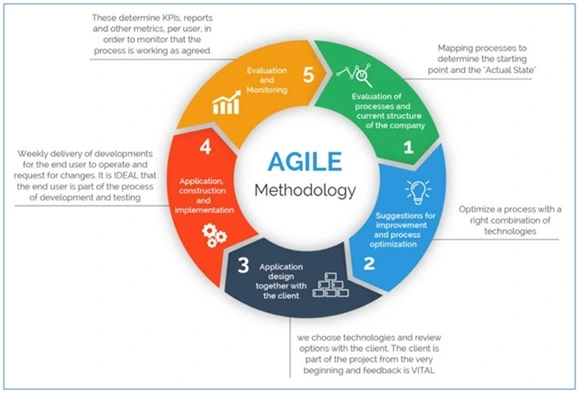Today, businesses must adapt to thrive in the digital age. Organizations are constantly pivoting to meet customer demands and stay ahead of the curve. This can be challenging for companies operating within specific industries or with limited resources. It’s especially true for project management teams that operate within highly regulated industries like healthcare, insurance, and finance.
This article will discuss why you should use agile project management, what it entails, and how it can positively impact your business processes by reducing red tape, increasing collaboration between team members, and improving efficiency across your organization as a whole.
What is Agile Project Management?
Agile project management is a software development methodology that focuses on speed, collaboration, and customer satisfaction. Compared to traditional project management methodologies, agile practices are heavily focused on the team’s ability to react quickly to change and deliver results faster. This is one of the main reasons that agile has become so popular in industries like software development, where the nature of the work is highly unpredictable.
Agile project management was developed by a group of software engineers in the early 2000s who were frustrated by the rigid, waterfall model of project management. The agile methodology takes into account the widely held belief that software projects have an element of uncertainty in them and therefore cannot be planned definitively. In contrast, waterfall project management assumes that the project objectives are known and unchanging and that the project can be broken down into a series of steps that can be followed in sequence and completed within a set period of time.
Why Is Agile Project Management So Important?
Companies that use traditional project management methodologies often struggle to keep up with changes in technology, evolving business goals, and customer needs. This is because project plans are often created without input from the team members closest to the work. Once the plan is approved, it’s difficult for individuals to change the direction of their work without running into major scheduling issues. As a result, team members spend their time completing tasks that no longer make sense in the context of the business objectives. This can create a backlog of work that negatively impacts employee productivity and the company’s bottom line. Agile project management can help to alleviate these issues by promoting the use of short project plans that can be easily adjusted based on feedback from team members.
These plans are designed to promote teamwork, transparency, and give stakeholders insight into the work being done on their behalf. Additionally, because agile project managers have less control over their team members’ daily activities, they rely heavily on collaboration to complete their projects successfully.
Benefits of Implementing Agile Practices
When properly implemented, agile practices can help to eliminate a number of issues that plague businesses throughout the world. Agile practices help teams to:
– Adopt a more sustainable pace of work
– When companies are newly formed or growing at a rapid pace, it can be difficult to maintain a sustainable work pace. This can often lead to team members burning out or feeling overwhelmed by their workload.
– Learn from past mistakes
– One of the key benefits of agile project management is that it encourages team members to reflect on their past work and use those lessons to inform their future decisions.
– Improve communication
– Collaboration is one of the central tenants of agile project management, which means that team members are spending more time communicating with one another.
– Deliver projects with reduced risk
– By encouraging continuous reflection on a project’s objectives and making changes as necessary, project managers can decrease the risk of the team delivering a product or service that doesn’t meet customer expectations.
4 Ways Agile Practices Can Benefit Your Business
As we’ve seen above, there are a number of ways that agile practices can benefit your business. However, there are a few specific ways in which agile practices can positively impact your business in particular. Those include:
– Improved project visibility
– Several of the key practices within the agile methodology are designed to improve the visibility of projects.
– Better customer satisfaction
– The more involved stakeholders are in the development process, the more likely it is that they’ll be satisfied with the product or service that’s delivered.
– Reduced project risk
– By improving the visibility of projects, you can also reduce the risk of unplanned changes that might throw a project off track.
– Increased productivity
– When team members know what their responsibilities are and how their work impacts others, they’re more likely to be focused and effective in their work.
3 Problems with Current Agile Practices in Businesses
While agile project management has proven to be successful in many organizations, there are a few nuances that have proven to be problematic. If you aren’t already familiar with these issues, it’s important that you understand them so that you can ensure the implementation of agile practices is successful. These problems include:
– Stakeholder frustration
– In the early days of agile project management, team members were effectively empowered to make decisions without consulting the stakeholders who requested the work. Today, stakeholders are more likely to be involved in the project, but they may experience frustration if they feel they aren’t being listened to or have limited insight into what their team members are working on.
– Lack of project visibility
– With limited insight into the work being done on their behalf, stakeholders may feel as though they have limited control over the project and lack any accountability for the outcome.
– Lack of resources
– In an effort to respond to change quickly and efficiently, many companies are adopting agile practices but aren’t fully training their employees in the process. This can lead to a lack of consistency and may prevent your team members from operating at full capacity.
How to Incorporate Lean Practices in an Agile Environment?
If you’ve identified problems with your existing agile approach, it’s important that you take the necessary steps to address them. One way to do so is by incorporating lean practices into your agile environment. Lean project management has some similarities to agile, but it also has some key differences. It’s important that you understand those differences so that you can make the necessary adjustments to ensure your business is maximizing the benefits of agile.
The first step to integrating lean practices into an agile environment is to select an agile methodology to follow. While there are numerous agile methodologies out there, some have proven to be more successful in large organizations than others. This is largely due to the amount of change they require. For example, Scrumbut is a methodology that’s built on the principles of Scrum but also calls for some additional changes. Other methodologies, like the Risk-Value-Driven (RVD) methodology, require even less change in order to be implemented effectively.
What is Included in an Agile PM Process?
The exact process that your agile project management team follows will depend on the methodology they’ve chosen to follow. Generally speaking, though, most agile projects follow a similar process. The important thing to remember is that this process is often very different from the process that your team uses in their day-to-day work. Once you’ve selected an agile methodology, it’s important that you include the following steps in the process:
– Understand the business problem
– To ensure that the project is adding value to the business, project managers must understand the problem that they’re solving before they begin to brainstorm potential solutions.
– Create a team
– While it might seem obvious, it’s important to note that team composition makes a significant impact on project success. A project team that is well-rounded and balances many different skill sets is more likely to succeed than a project team that consists of individuals who all have the same skill set.
– Plan the project
– The team will use the problem statement and the composition of their team to determine the best course of action for solving the problem. Once they’ve decided on a solution, they’ll create a project plan that outlines the work that needs to be done, the resources that will be required to do the work, and the timeline they expect the work to take.
– Break down the work
Many of these fields have strict compliance standards and often require lengthy documentation processes. In order to streamline business operations while still meeting regulatory requirements, many companies are embracing agile project management strategies.






113 thoughts on “5 Ways Agile Project Management Can Save Your Business”
[…] Another popular project management framework in finance is Agile. Agile methodology, such as Scrum and Kanban, are known for their flexibility and adaptability. They are particularly […]
Awesome post. Really Great.
Hey, thanks for the blog. Really Cool.
Im thankful for the blog post.Much thanks again. Great.
Hey, thanks for the blog.Really thank you! Really Great.
Very good blog article. Keep writing.
Appreciate you sharing, great blog article.Thanks Again.
Im thankful for the post.Really looking forward to read more. Fantastic.
Hey, thanks for the article.Much thanks again. Will read on…
Wow, great blog post.Really thank you! Really Cool.
Enjoyed every bit of your blog article.Really thank you! Fantastic.
I loved your blog article.Thanks Again. Want more.
Im obliged for the article post.Thanks Again. Want more.
I am so grateful for your blog article. Awesome.
Im thankful for the blog article.Really looking forward to read more. Really Cool.
Thank you ever so for you article post.Really thank you! Cool.
A round of applause for your blog.Really looking forward to read more.
I truly appreciate this blog post.Really looking forward to read more. Awesome.
Thanks again for the article post.Really looking forward to read more.
Thank you for your blog article.Much thanks again. Really Great.
A round of applause for your blog post.Much thanks again. Fantastic.
Thanks a lot for the article post.Thanks Again. Want more.
Say, you got a nice blog. Really Cool.
Major thanks for the blog post.Really thank you! Want more.
Thanks for the blog post.Really looking forward to read more. Want more.
Very neat blog.Really looking forward to read more. Really Cool.
Very informative blog article.Thanks Again. Fantastic.
Really appreciate you sharing this blog.Really thank you! Great.
Great, thanks for sharing this article.Much thanks again. Fantastic.
Muchos Gracias for your article post.Much thanks again. Really Cool.
This is one awesome blog.Really thank you! Fantastic.
This is one awesome blog post.Really looking forward to read more.
Wow, great blog.Really looking forward to read more. Cool.
Im thankful for the article. Fantastic.
Thanks a lot for the post.Thanks Again. Really Cool.
I appreciate you sharing this article post. Keep writing.
Major thankies for the blog article.Much thanks again. Really Great.
A round of applause for your blog post.Much thanks again. Keep writing.
Looking forward to reading more. Great blog post.Much thanks again. Want more.
Enjoyed every bit of your blog.Really looking forward to read more. Really Great.
Fantastic blog post.Thanks Again.
Thank you for your post.Thanks Again. Much obliged.
Thank you for your post.Really looking forward to read more. Want more.
I think this is a real great blog post.Much thanks again. Great.
Really informative post.Really thank you! Awesome.
Very neat blog post. Want more.
I really liked your blog. Cool.
Thanks for sharing, this is a fantastic article post.Much thanks again. Keep writing.
Major thanks for the article post.Really thank you! Cool.
Wow, great blog.Really thank you! Cool.
Really appreciate you sharing this blog post.Much thanks again. Really Great.
Thanks so much for the blog post.Really thank you! Great.
Great, thanks for sharing this blog article.Much thanks again. Really Great.
Major thanks for the blog.Really thank you! Much obliged.
Muchos Gracias for your blog.Really looking forward to read more. Want more.
I value the blog post. Really Great.
I am so grateful for your blog.Really thank you! Much obliged.
Fantastic blog.Thanks Again. Want more.
Major thankies for the article post.Thanks Again. Awesome.
Thanks again for the article. Will read on…
A big thank you for your article.Really thank you! Great.
I really like and appreciate your article post. Great.
Thanks so much for the article post.Really looking forward to read more. Fantastic.
I am so grateful for your article.Really thank you! Really Cool.
Great article post.Much thanks again. Really Great.
Awesome article post.Thanks Again. Keep writing.
Thanks for the article post.Really thank you! Fantastic.
wow, awesome blog article.Really looking forward to read more. Will read on…
Thanks a lot for the blog. Much obliged.
I really enjoy the post.Much thanks again. Will read on…
Say, you got a nice post.Really thank you! Much obliged.
Very neat article.Thanks Again. Really Great.
I cannot thank you enough for the article post.Thanks Again. Keep writing.
Very informative article post.Really looking forward to read more.
Muchos Gracias for your blog. Great.
Thanks for the blog.Really thank you! Really Great.
wow, awesome blog.Thanks Again. Awesome.
I am so grateful for your blog article.Much thanks again. Want more.
I truly appreciate this blog article.Really thank you! Really Cool.
Really appreciate you sharing this blog post. Much obliged.
I cannot thank you enough for the article post.Much thanks again. Cool.
Really appreciate you sharing this blog.Really thank you! Really Great.
I value the blog post.Thanks Again. Fantastic.
Really appreciate you sharing this blog article.Really looking forward to read more. Want more.
Thanks a lot for the blog.Really thank you! Want more.
Really enjoyed this post.Really thank you! Keep writing.
I think this is a real great post.Really thank you! Want more.
Appreciate you sharing, great article.Thanks Again.
I think this is a real great article post.Thanks Again. Really Cool.
Fantastic blog.Really looking forward to read more. Really Cool.
Thanks a lot for the blog.Much thanks again. Really Cool.
Really enjoyed this article post.Much thanks again. Want more.
Wow, great blog post.Really looking forward to read more. Really Great.
Thanks a lot for the blog post. Great.
Im obliged for the post. Want more.
A big thank you for your blog post.Thanks Again. Want more.
Really informative blog article.Much thanks again. Fantastic.
Very neat blog article.Really thank you! Great.
Muchos Gracias for your post.Really looking forward to read more.
A big thank you for your blog. Cool.
I got what you mean , regards for posting.Woh I am pleased to find this website through google. “I would rather be a coward than brave because people hurt you when you are brave.” by E. M. Forster.
“Very interesting points you have mentioned , thankyou for posting . “Without courage, wisdom bears no fruit.””
Can you be more specific about the content of your article? After reading it, I still have some doubts. Hope you can help me.
“There’s definately a lot to learn about this subject. I like all the points you made.Very well written!”
“Mega good! Interesting informations over this site. It is pretty worth enough for me. In my view, if all site owners and bloggers made good content as you did, the net will be a lot more useful than ever before. I could not refrain from commenting. I have spent 2 hours trying to find such infos. I will also share it with some friends interested in it. I’ve just bookmarked this web.”
Some genuinely excellent information, Gladiola I detected this. “As long as a word remains unspoken, you are it’s master once you utter it, you are it’s slave.” by Solomon Ibn Gabirol.
“Tremendous things here. I’m very happy to look your article. Thank you a lot and I am looking ahead to touch you”
Your point of view caught my eye and was very interesting. Thanks. I have a question for you.
Hello there, just was alert to your weblog thru Google, and located that it’s really informative. I am gonna watch out for brussels. I’ll appreciate in the event you continue this in future. Many people can be benefited out of your writing. Cheers!
Wow, that’s what I was seeking for, what a stuff! existing here at this web site, thanks admin of this web page.
Attractive section of content. I just stumbled upon your weblog and in accession capital to assert that I get actually enjoyed account your blog posts. Anyway I’ll be subscribing to your augment and even I achievement you access consistently rapidly.
Thank you for your sharing. I am worried that I lack creative ideas. It is your article that makes me full of hope. Thank you. But, I have a question, can you help me?
Your article helped me a lot, is there any more related content? Thanks!